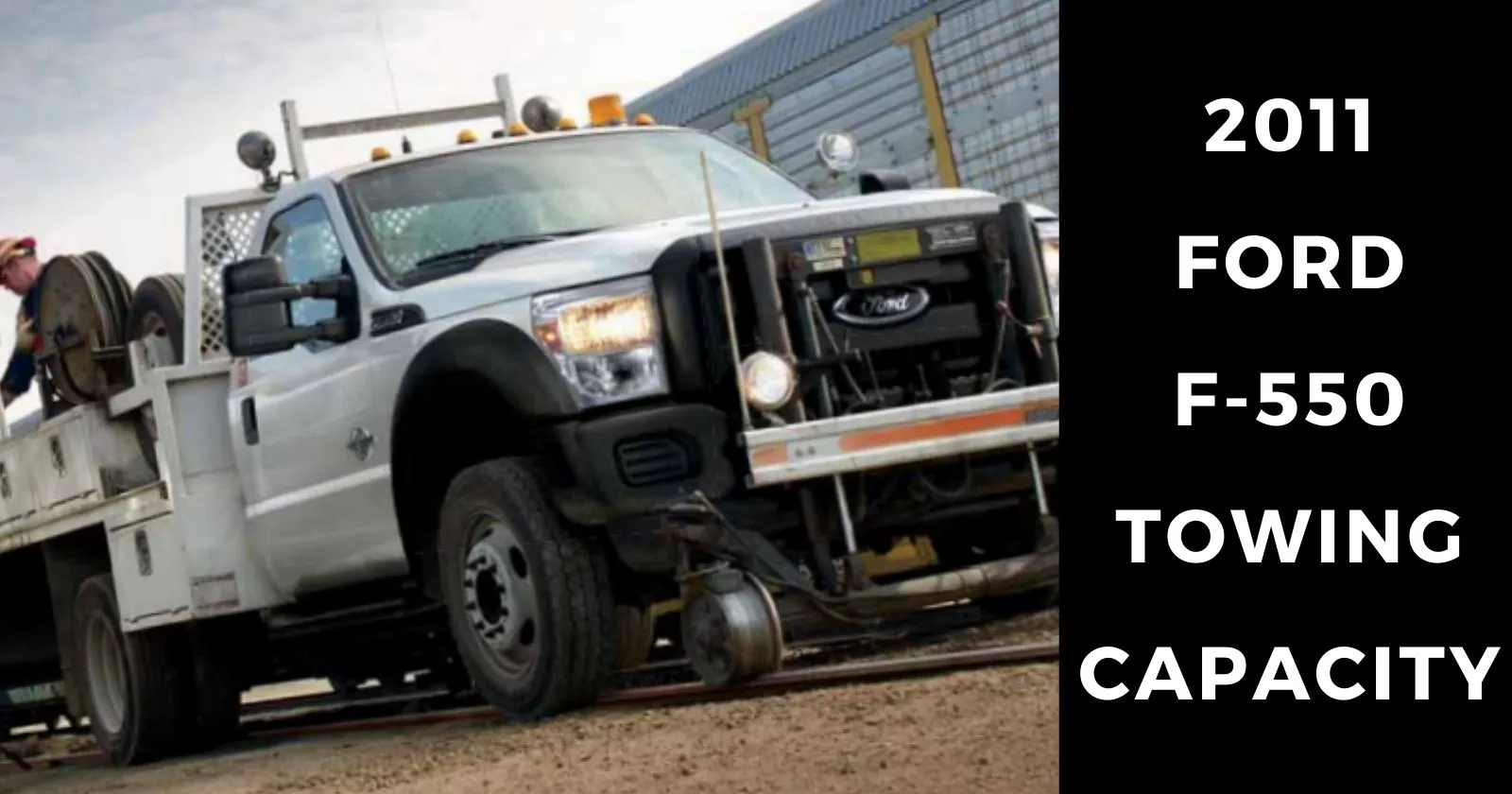When it comes to heavy-duty trucks, the 2011 Ford F550 is a popular choice among professionals in various industries. Its powerful engine and exceptional towing capacity make it an ideal option for those who need to tow heavy loads.
In this article, we will provide a comprehensive guide to the 2011 Ford F550 towing capacity, including its features, towing capabilities, and more.
So, without further ado, let’s get started.
Table of Contents
2011 Ford F550 Engine Options
The 2011 F550 Super Duty Chassis Cab is powered by a 6.7L V8 Power Stroke Diesel Engine. Plus, the truck also comes with a 6.8L 3V SOHC V10 Gasoline Engine that is mated to a 5-seed TorqShift Automatic Transmission.
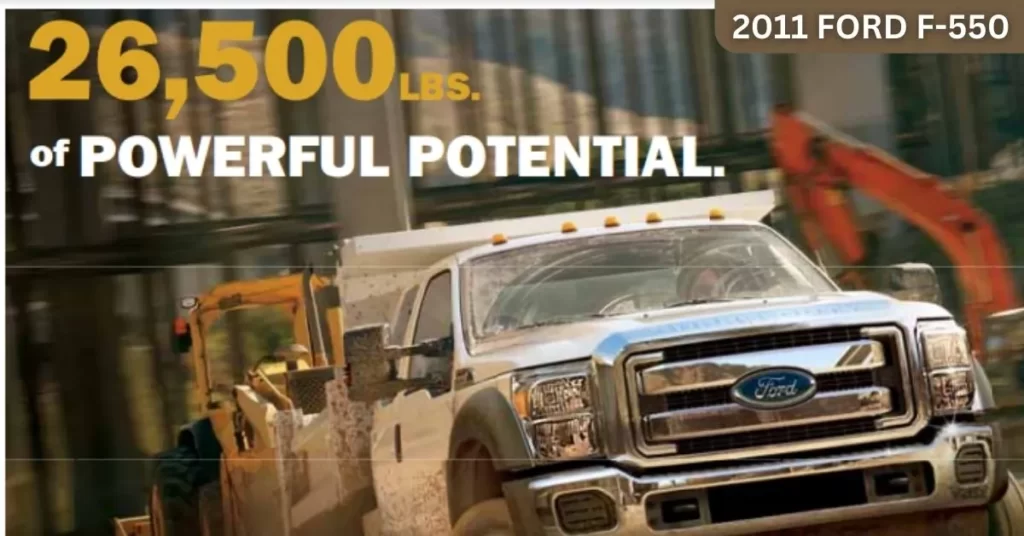
2011 Ford F550 Towing Capacity according to the engine type
Super Duty Chassis Cabs
| ENGINE TYPE | CONVENTIONAL TOWING | 5TH-WHEEL TOWING |
| 6.8L V10 Turbo Diesel | 16,000 lbs | 18,300 lbs |
| 6.7L V8 Turbo Diesel | 16,000 lbs | 26,500 lbs |
The robust 6.8L Power Stroke Diesel 3V SOHC V10 engine has proven its mettle with its impressive strength, delivering optimal towing capabilities. With a peak horsepower of 362 and a pinnacle torque of 457 lb.-ft, this powerhouse, when coupled with the F550, offers a maximum conventional towing capacity of 16,000 lbs and an impressive 5th-wheel towing capacity of 18,300 lbs.
On the other hand, the 6.7L V8 Gas engine showcases an exceptional performance that sets it apart from the rest in its class, producing a maximum power output of 400 horsepower and a staggering torque of 800 lb.-ft. Its unmatched horsepower and torque capabilities make it a force to be reckoned with. Outfitted with this engine, the 2011 Ford F550 can haul up to 16,000 lbs for conventional towing and an astonishing 26,500 lbs for 5th-wheel towing, making it an unbeatable choice for heavy-duty hauling.
Now, it’s time to explore the 2011 Ford F550 Towing Charts.
The 2011 F550 is available on Super Duty Chassis Cabs. DRW Regular Cab Chassis, DRW Supercab Chassis, and DRW Crew Cab Chassis are the configurations for the F550.
CONVENTIONAL TOWING CHART
2011 Ford F550 Towing Capacity Chart–Regular Cab Chassis (DRW Conventional Towing)
| CONFIGURATION | ENGINE | AXLE RATIO | GCWR | TOWING CAPACITY |
| 4×2 DRW | 6.8L SOHC V10 | 4.88 | 26,000 lbs | 16,000 lbs |
| 4×4 DRW | 6.8L SOHC V10 | 4.88 | 26,000 lbs | 16,000 lbs |
| 4×2 DRW | 6.7L V8 Turbo Diesel | 4.10 | 26,000 lbs | 16,000 lbs |
| 4×2 DRW | 6.7L V8 Turbo Diesel | 4.30 | 35,000 lbs | 16,000 lbs |
| 4×2 DRW | 6.7L V8 Turbo Diesel | 4.88 | 26,000 lbs | 16,000 lbs |
| 4×2 DRW | 6.7L V8 Turbo Diesel | 4.88 | 35,000 lbs | 16,000 lbs |
| 4×4 DRW | 6.7L V8 Turbo Diesel | 4.10 | 26,000 lbs | 16,000 lbs |
| 4×4 DRW | 6.7L V8 Turbo Diesel | 4.30 | 35,000 lbs | 16,000 lbs |
| 4×4 DRW | 6.7L V8 Turbo Diesel | 4.88 | 26,000 lbs | 16,000 lbs |
| 4×4 DRW | 6.7L V8 Turbo Diesel | 4.88 | 35,000 lbs | 16,000 lbs |
2011 Ford F550 Towing Capacity Chart–Supercab Chassis (DRW Conventional Towing)
| CONFIGURATION | ENGINE | AXLE RATIO | GCWR | TOWING CAPACITY |
| 4×2 DRW | 6.8L SOHC V10 | 4.88 | 26,000 lbs | 16,000 lbs |
| 4×4 DRW | 6.8L SOHC V10 | 4.88 | 26,000 lbs | 16,000 lbs |
| 4×2 DRW | 6.7L V8 Turbo Diesel | 4.10 | 26,000 lbs | 16,000 lbs |
| 4×2 DRW | 6.7L V8 Turbo Diesel | 4.30 | 35,000 lbs | 16,000 lbs |
| 4×2 DRW | 6.7L V8 Turbo Diesel | 4.88 | 26,000 lbs | 16,000 lbs |
| 4×2 DRW | 6.7L V8 Turbo Diesel | 4.88 | 35,000 lbs | 16,000 lbs |
| 4×4 DRW | 6.7L V8 Turbo Diesel | 4.10 | 26,000 lbs | 16,000 lbs |
| 4×4 DRW | 6.7L V8 Turbo Diesel | 4.30 | 35,000 lbs | 16,000 lbs |
| 4×4 DRW | 6.7L V8 Turbo Diesel | 4.88 | 26,000 lbs | 16,000 lbs |
| 4×4 DRW | 6.7L V8 Turbo Diesel | 4.88 | 35,000 lbs | 16,000 lbs |
2011 Ford F550 Towing Capacity Chart–Crew Cab Chassis (DRW Conventional Towing)
| CONFIGURATION | ENGINE | AXLE RATIO | GCWR | TOWING CAPACITY |
| 4×2 DRW | 6.8L SOHC V10 | 4.88 | 26,000 lbs | 16,000 lbs |
| 4×4 DRW | 6.8L SOHC V10 | 4.88 | 26,000 lbs | 16,000 lbs |
| 4×2 DRW | 6.7L V8 Turbo Diesel | 4.10 | 26,000 lbs | 16,000 lbs |
| 4×2 DRW | 6.7L V8 Turbo Diesel | 4.30 | 35,000 lbs | 16,000 lbs |
| 4×2 DRW | 6.7L V8 Turbo Diesel | 4.88 | 26,000 lbs | 16,000 lbs |
| 4×2 DRW | 6.7L V8 Turbo Diesel | 4.88 | 35,000 lbs | 16,000 lbs |
| 4×4 DRW | 6.7L V8 Turbo Diesel | 4.10 | 26,000 lbs | 16,000 lbs |
| 4×4 DRW | 6.7L V8 Turbo Diesel | 4.30 | 35,000 lbs | 16,000 lbs |
| 4×4 DRW | 6.7L V8 Turbo Diesel | 4.88 | 26,000 lbs | 16,000 lbs |
| 4×4 DRW | 6.7L V8 Turbo Diesel | 4.88 | 35,000 lbs | 16,000 lbs |
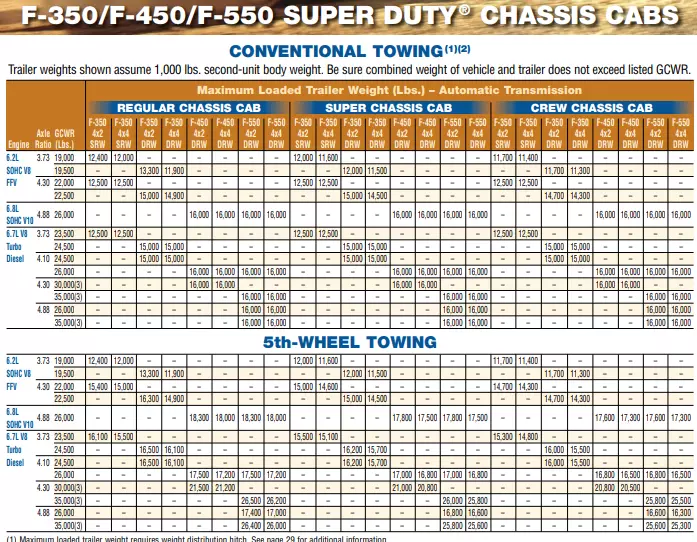
5TH-WHEEL TOWING CHART
2011 Ford F550 Towing Capacity Chart–Regular Cab Chassis (DRW 5th-Wheel Towing)
| CONFIGURATION | ENGINE | AXLE RATIO | GCWR | TOWING CAPACITY |
| 4×2 DRW | 6.8L SOHC V10 | 4.88 | 26,000 lbs | 18,300 lbs |
| 4×4 DRW | 6.8L SOHC V10 | 4.88 | 26,000 lbs | 18,000 lbs |
| 4×2 DRW | 6.7L V8 Turbo Diesel | 4.10 | 26,000 lbs | 17,500 lbs |
| 4×2 DRW | 6.7L V8 Turbo Diesel | 4.30 | 35,000 lbs | 26,500 lbs |
| 4×2 DRW | 6.7L V8 Turbo Diesel | 4.88 | 26,000 lbs | 17,400 lbs |
| 4×2 DRW | 6.7L V8 Turbo Diesel | 4.88 | 35,000 lbs | 26,400 lbs |
| 4×4 DRW | 6.7L V8 Turbo Diesel | 4.10 | 26,000 lbs | 17,200 lbs |
| 4×4 DRW | 6.7L V8 Turbo Diesel | 4.30 | 35,000 lbs | 26,200 lbs |
| 4×4 DRW | 6.7L V8 Turbo Diesel | 4.88 | 26,000 lbs | 17,000 lbs |
| 4×4 DRW | 6.7L V8 Turbo Diesel | 4.88 | 35,000 lbs | 26,000 lbs |
2011 Ford F550 Towing Capacity Chart–Supercab Chassis (DRW 5th-Wheel Towing)
| CONFIGURATION | ENGINE | AXLE RATIO | GCWR | TOWING CAPACITY |
| 4×2 DRW | 6.8L SOHC V10 | 4.88 | 26,000 lbs | 17,800 lbs |
| 4×4 DRW | 6.8L SOHC V10 | 4.88 | 26,000 lbs | 17,500 lbs |
| 4×2 DRW | 6.7L V8 Turbo Diesel | 4.10 | 26,000 lbs | 17,000 lbs |
| 4×2 DRW | 6.7L V8 Turbo Diesel | 4.30 | 35,000 lbs | 26,000 lbs |
| 4×2 DRW | 6.7L V8 Turbo Diesel | 4.88 | 26,000 lbs | 16,800 lbs |
| 4×2 DRW | 6.7L V8 Turbo Diesel | 4.88 | 35,000 lbs | 25,800 lbs |
| 4×4 DRW | 6.7L V8 Turbo Diesel | 4.10 | 26,000 lbs | 16,800 lbs |
| 4×4 DRW | 6.7L V8 Turbo Diesel | 4.30 | 35,000 lbs | 25,800 lbs |
| 4×4 DRW | 6.7L V8 Turbo Diesel | 4.88 | 26,000 lbs | 16,600 lbs |
| 4×4 DRW | 6.7L V8 Turbo Diesel | 4.88 | 35,000 lbs | 25,600 lbs |
2011 Ford F550 Towing Capacity Chart–Crew Cab Chassis (DRW 5th-Wheel Towing)
| CONFIGURATION | ENGINE | AXLE RATIO | GCWR | TOWING CAPACITY |
| 4×2 DRW | 6.8L SOHC V10 | 4.88 | 26,000 lbs | 17,600 lbs |
| 4×4 DRW | 6.8L SOHC V10 | 4.88 | 26,000 lbs | 17,300 lbs |
| 4×2 DRW | 6.7L V8 Turbo Diesel | 4.10 | 26,000 lbs | 16,800 lbs |
| 4×2 DRW | 6.7L V8 Turbo Diesel | 4.30 | 35,000 lbs | 25,800 lbs |
| 4×2 DRW | 6.7L V8 Turbo Diesel | 4.88 | 26,000 lbs | 16,600 lbs |
| 4×2 DRW | 6.7L V8 Turbo Diesel | 4.88 | 35,000 lbs | 25,600 lbs |
| 4×4 DRW | 6.7L V8 Turbo Diesel | 4.10 | 26,000 lbs | 16,500 lbs |
| 4×4 DRW | 6.7L V8 Turbo Diesel | 4.30 | 35,000 lbs | 25,500 lbs |
| 4×4 DRW | 6.7L V8 Turbo Diesel | 4.88 | 26,000 lbs | 16,300 lbs |
| 4×4 DRW | 6.7L V8 Turbo Diesel | 4.88 | 35,000 lbs | 25,300 lbs |
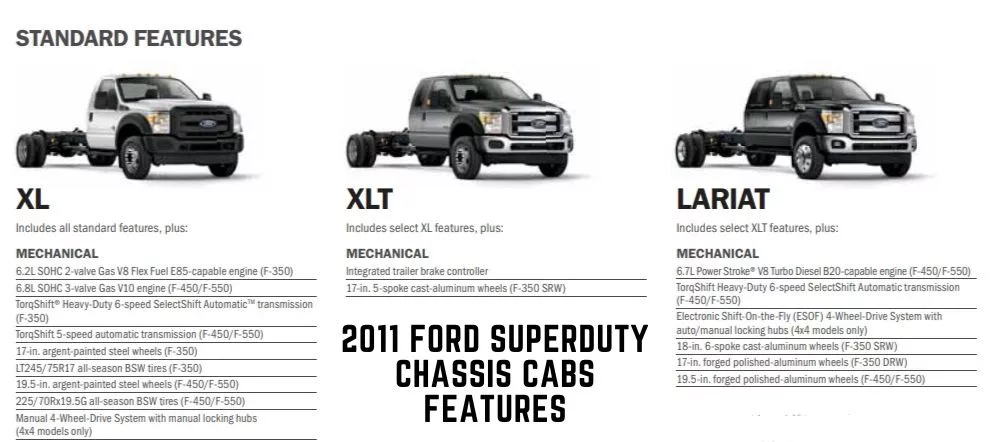
Explore More: 2023 Ford F550 Towing Capacity 2022 Ford F550 Towing Capacity 2021 Ford F550 Towing Capacity 2020 Ford F550 Towing Capacity 2019 Ford F550 Towing Capacity 2018 Ford F550 Towing Capacity 2017 Ford F550 Towing Capacity 2016 Ford F550 Towing Capacity 2015 Ford F550 Towing Capacity 2014 Ford F550 Towing Capacity 2013 Ford F550 Towing Capacity 2012 Ford F550 Towing Capacity
Towing Features on 2011 Ford F550
The 2011 Ford F550 was outfitted with various trailering features including the Standard Trailer Sway Control, Trailer Brake Controller, Standard Hill Start Assist, and 5th-Wheel/Gooseneck Prep Package.
Standard Trailer Sway Control
The Single-rear-wheel (SRW) models were furnished with the Standard Trailer Sway Control feature, which operates in conjunction with AdvanceTrac and RSC (Roll Stability Control) systems by utilizing a yaw motion sensor to monitor the movements of the vehicle and detecting any trailer sway. The system employs targeted braking and reduces engine power to assist the driver in regaining control of the vehicle in the event of trailer sway. Furthermore, Dual-rear-wheel (DRW) models, though lacking the AdvanceTrac technology, were outfitted with a comparable yaw motion sensor to identify and regulate trailer sway.
Trailer Brake Controller (TBC)
The Trailer Brake Controller (TBC) in the 2011 Ford F550 makes use of braking input, vehicle speed, and Anti-lock Braking System (ABS) logic to balance the performance of the truck brakes and electric trailer brakes. The instrument cluster displays the trailer brake controller output, gain levels, and trailer connection status for the driver’s convenience.
In addition to providing greater control and enhanced braking, the TBC also integrates Tow/Haul Mode with the engine brake, which is available only on the 6.7L Diesel V8 engine. This feature eliminates unwanted gear shifting frequencies on steep uphill grades and allows the engine braking system to maintain or reduce vehicle speed.
Moreover, the TBC feature combined with the engine brake on the 6.7L V8 turbo diesel engine provides additional braking and control on downhill grades, ensuring a safer and more efficient towing experience. By utilizing the TBC and engine brake integration in the 2011 Ford F550, drivers can optimize their vehicle’s performance and improve their overall towing experience.
Standard Hill Start Assist
Hill Start Assist helps to prevent rolling back on a grade by momentarily maintaining brake pressure until the engine delivers enough torque to move the truck up the hill. You’re always covered while heading up, or in reverse mode.
5th-Wheel/Gooseneck Prep Package
All models of the 2011 Ford F450 Pickup truck were available with the 5th-wheel/Gooseneck Prep Package which provides the necessary under-the-bed hardware to allow mounting of a 5th-wheel/gooseneck hitch in the pickup bed to put more of the trailer weight over the tow vehicle.
Some Safety Tips for Towing with the 2011 Ford F550
Towing can be dangerous if not done correctly. Here are some towing safety tips to keep in mind when towing with your 2011 Ford F550:
- Always make sure that the trailer is properly hitched to the truck and that all safety chains and electrical connections are secure.
- Check the weight distribution of the trailer to ensure that it’s balanced and that the weight is evenly distributed.
- Adjust your driving habits to account for the extra weight and length of the trailer. Take wider turns, leave more space for braking, and avoid sudden movements.
- Check your brakes, tires, and lights before towing to ensure that they’re in good working condition.
- Never exceed your truck’s towing capacity or the capacity of the hitch.
Conclusion on 2011 Ford F550 Towing Capacity
In summary, the 2011 Ford F550 is an exceptional heavy-duty truck with impressive towing capacity. With the right equipment and careful planning, it can safely and efficiently tow heavy loads.
Regular maintenance of your truck is also essential to ensure that it’s in good working condition and can handle the strain of towing. By following these tips, you can safely and efficiently tow with your 2011 Ford F550.
By following the tips outlined in this article, you can ensure a successful tow and protect both yourself and your equipment.
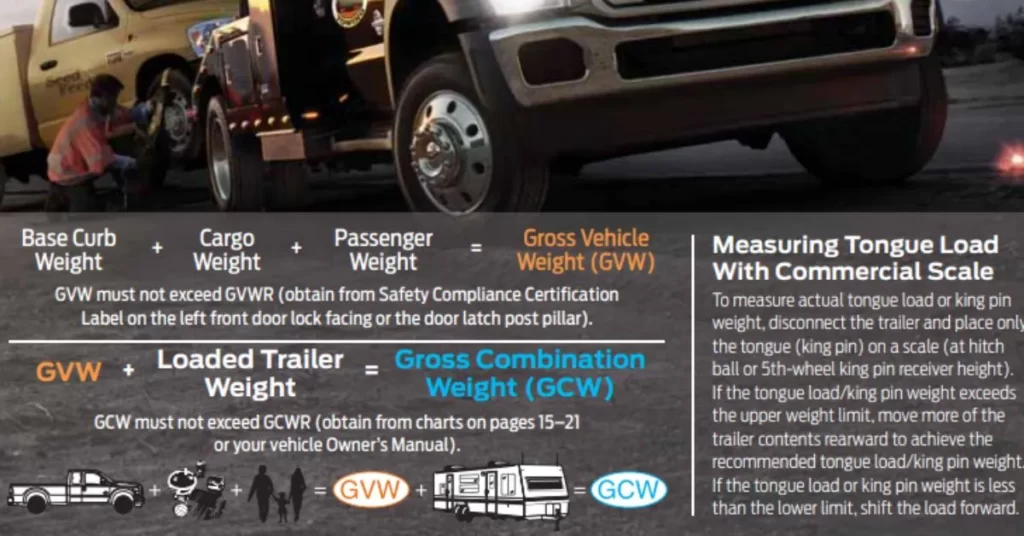
How to calculate the load your vehicle can carry/tow?
1. Use the appropriate maximum GCWR chart (in the Trailer Towing section in this chapter) for your type of engine and rear axle ratio.
2. Weigh your vehicle without cargo. To obtain the correct weights, take your vehicle to a shipping company or an inspection station for trucks.
3. Subtract your loaded weight from the maximum GCWR in the chart. This is the maximum trailer weight your vehicle can tow. It must be below the maximum trailer weight shown in the chart.
Some Important Information on 2011 Ford F550 Towing Capacity
- Maximum trailer weight for bumper towing is 5,000 lbs.
- Trailer tongue load weight should be 10-15% of the total loaded trailer weight.
- The combined weight of the vehicle and trailer cannot exceed the GCWR in the vehicle manual.
- F550 owners must read and review the owner’s manual before towing.
- The 2011 F550’s maximum towing capacity requires a powerful engine, Max Trailer Tow Package, specific tires, and wheels, and approved towing accessories.
- Towing capacity depends on the vehicle configuration, cargo, passenger weight, trailer tongue weight, towing accessories, and customizations.
- Your vehicle can tow class I, II, or III trailers if the maximum weight is within the limits listed for your engine and rear axle ratio on the provided charts.
- Load capacity is determined by weight, not volume, so not all available space may be used when loading.
- Towing puts extra load on the vehicle’s engine, transmission, axle, brakes, tires, and suspension, so these components should be inspected regularly during and after towing.
Stellan Carter is an accomplished writer, entrepreneur, and avid Ford Raptor owner. As a co-founder and content contributor for this renowned blog website, Stellan brings a wealth of knowledge and expertise to the automotive industry. When he's not behind the wheel of his beloved Ford Raptor, Stellan can be found exploring new terrains, capturing the essence of his automotive adventures through his camera lens.

